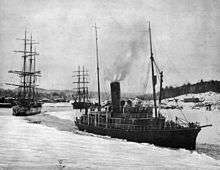CGS Stanley
 The Canadian Government Ship Stanley escorting two vessels. | |
| History | |
|---|---|
| Name: | Stanley |
| Builder: | Fairfield Shipbuilding and Engineering, Glasgow |
| Completed: | 1888 |
| In service: | 1888-1935 |
| Out of service: | 1935 |
| Fate: | Sold, 1935 |
| General characteristics | |
| Tonnage: | 914 gross register tons (GRT) |
| Length: | 207 ft (63 m) |
| Beam: | 32 ft (9.8 m) |
| Draught: | 13.5 ft (4.1 m) |
| Propulsion: | Steam triple steam engine, 2,300 hp (1,715 kW) (nominal) |
The CGS Stanley has been described as Canada's first truly effective icebreaker.[1][2] She was launched in 1888, and remained in service until 1936.[3]
On May 2, 1922, the Stanley rescued an American steamer Cairnmona, when she was disabled off the coast of Cape Breton Island.[4]
In 1927 a scientific expedition based on the Stanley and a commercial vessel was tasked to determine the safe navigation season for vessels using the new port facilities at Churchill, Manitoba, the only port on the Arctic Ocean connected to the North American Railroad Grid.[5] The Aviators of Hudson Strait, a 1973 Canadian short documentary film produced by the National Film Board of Canada (NFB) for the Department of National Defence (Canada) was made of the 1927–1928 expedition.[6]
References
- ↑ Thomas E. Appleton (1969). "Usque Ad Mare : Historique de la Garde Côtière Canadienne Et Des Services de la Marine". Canadian Department of Transport. p. 54. Retrieved 2013-12-30.
Of 2300 indicated horsepower, the Stanley was a powerful little ship for her day.
- ↑ "CGS Stanley". Canadian Nautical Collection. Archived from the original on 2013-12-31. Retrieved 2013-12-30.
The CGS Stanley was Canada’s first truly effective icebreaker, launched from Fairfield Shipbuilding and Engineering at Govan and entering winter service between Charlottetown and Pictou in 1888.
- ↑ "Archived copy". Archived from the original on 2009-09-13. Retrieved 2015-08-25.
- ↑ "American Shipping, Volume 15". American Shipping News. 1922. Retrieved 2013-12-30.
...Sunday being in the ice with rudder disable near River Inhabitants, on the Cape Breton coast, arrived here convoyed by the C.G.S. Stanley, which responded to her calls for assistance.
- ↑ Howard A. Fleming (1957). "Canada's Arctic Outlet: A History of the Hudson Bay Railway". University of California Press. Retrieved 2013-12-30.
Nor was the problem of navigation in Hudson Strait neglected. In January 1927, the decision was made to send a new and bona fide expedition to examine ice conditions and "to study the requirements necessary to ensure safe navigation." The expedition, under the command of N.B. McLean, left Halifax July 17, 1927, in two ships, the C.G.S. Stanley and the S.S. Larch, carrying equipment and personnel to man three base camps, one at each end of the Strait and one in the middle.
- ↑ Weldon, Carolyne. "Jets, Floatplanes and Bombers: 15 NFB Films about Planes." National Film Board of Canada, June 14, 2012. Retrieved: January 14, 2016.